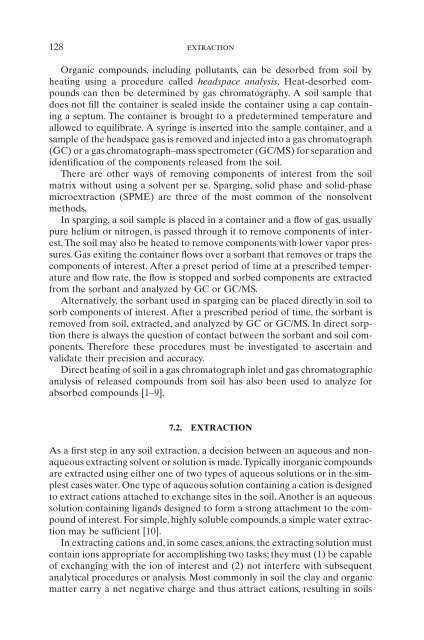Introduction to Soil Chemistry
Introduction to Soil Chemistry
Introduction to Soil Chemistry
You also want an ePaper? Increase the reach of your titles
YUMPU automatically turns print PDFs into web optimized ePapers that Google loves.
128 extraction<br />
Organic compounds, including pollutants, can be desorbed from soil by<br />
heating using a procedure called headspace analysis. Heat-desorbed compounds<br />
can then be determined by gas chroma<strong>to</strong>graphy. A soil sample that<br />
does not fill the container is sealed inside the container using a cap containing<br />
a septum. The container is brought <strong>to</strong> a predetermined temperature and<br />
allowed <strong>to</strong> equilibrate. A syringe is inserted in<strong>to</strong> the sample container, and a<br />
sample of the headspace gas is removed and injected in<strong>to</strong> a gas chroma<strong>to</strong>graph<br />
(GC) or a gas chroma<strong>to</strong>graph–mass spectrometer (GC/MS) for separation and<br />
identification of the components released from the soil.<br />
There are other ways of removing components of interest from the soil<br />
matrix without using a solvent per se. Sparging, solid phase and solid-phase<br />
microextraction (SPME) are three of the most common of the nonsolvent<br />
methods.<br />
In sparging, a soil sample is placed in a container and a flow of gas, usually<br />
pure helium or nitrogen, is passed through it <strong>to</strong> remove components of interest.<br />
The soil may also be heated <strong>to</strong> remove components with lower vapor pressures.<br />
Gas exiting the container flows over a sorbant that removes or traps the<br />
components of interest. After a preset period of time at a prescribed temperature<br />
and flow rate, the flow is s<strong>to</strong>pped and sorbed components are extracted<br />
from the sorbant and analyzed by GC or GC/MS.<br />
Alternatively, the sorbant used in sparging can be placed directly in soil <strong>to</strong><br />
sorb components of interest. After a prescribed period of time, the sorbant is<br />
removed from soil, extracted, and analyzed by GC or GC/MS. In direct sorption<br />
there is always the question of contact between the sorbant and soil components.<br />
Therefore these procedures must be investigated <strong>to</strong> ascertain and<br />
validate their precision and accuracy.<br />
Direct heating of soil in a gas chroma<strong>to</strong>graph inlet and gas chroma<strong>to</strong>graphic<br />
analysis of released compounds from soil has also been used <strong>to</strong> analyze for<br />
absorbed compounds [1–9].<br />
7.2. EXTRACTION<br />
As a first step in any soil extraction, a decision between an aqueous and nonaqueous<br />
extracting solvent or solution is made.Typically inorganic compounds<br />
are extracted using either one of two types of aqueous solutions or in the simplest<br />
cases water. One type of aqueous solution containing a cation is designed<br />
<strong>to</strong> extract cations attached <strong>to</strong> exchange sites in the soil. Another is an aqueous<br />
solution containing ligands designed <strong>to</strong> form a strong attachment <strong>to</strong> the compound<br />
of interest. For simple, highly soluble compounds, a simple water extraction<br />
may be sufficient [10].<br />
In extracting cations and, in some cases, anions, the extracting solution must<br />
contain ions appropriate for accomplishing two tasks; they must (1) be capable<br />
of exchanging with the ion of interest and (2) not interfere with subsequent<br />
analytical procedures or analysis. Most commonly in soil the clay and organic<br />
matter carry a net negative charge and thus attract cations, resulting in soils
















